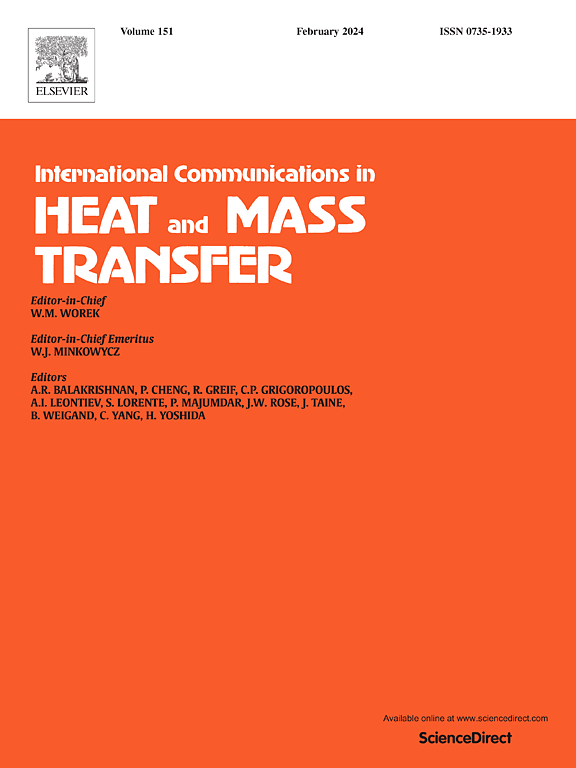Low-order diffusive heat and mass transfer model for convective–radiative heating of a wet brick during energy investigation of an electric oven: Static mode
IF 6.4
2区 工程技术
Q1 MECHANICS
International Communications in Heat and Mass Transfer
Pub Date : 2025-05-14
DOI:10.1016/j.icheatmasstransfer.2025.109002
引用次数: 0
Abstract
Electric ovens typically belong to the low-efficiency category among electric appliances, exhibiting efficiencies typically ranging from 10% to 12%. To enhance efficiency, the home appliance industry focuses primarily on integrating advanced technologies. The energy efficiency index (EEI) for these appliances is in accordance with the testing standards specified in the EN 60350-1 standard. During testing, a standard wet brick inside the oven undergoes controlled heating from its initial temperature to a specified level, underscoring the need for precise modelling techniques. In this study, we propose a low-order dynamic model designed to predict the transient thermo-fluid behaviour of a domestic electric oven during energy consumption tests conducted in natural convective mode. This model accounts for simultaneous heat and mass transfer between the cavity air and the wet brick, employing a lumped model approach that optimizes computational efficiency. The oven is systematically divided into five subsystems: door, cavity, ventilation, cabinet, and wet brick, modelled using fundamental equations. Boundary conditions are calibrated using empirical correlations derived from experimental data, imparting a grey-box characterization to the system. Model parameters are meticulously tuned and calibrated based on available physical data. Following calibration, the model undergoes verification against additional experimental data to ensure its accuracy. The model effectively predicts transient variables such as cavity wall temperature, brick core temperature, and ventilation flows well within permissible error margins. Furthermore, it forecasts oven energy consumption, brick heating duration, and water evaporation, all within acceptable error limits of 15%. This comprehensive approach not only enhances our understanding of oven performance dynamics but also contributes to optimizing energy efficiency in domestic electric appliances.
电炉能量研究中湿砖对流辐射加热的低阶扩散传热传质模型:静态模式
电烤箱通常属于电器中效率较低的一类,其效率通常在10%至12%之间。为了提高效率,家电行业的重点是整合先进技术。这些电器的能效指数(EEI)符合EN 60350-1标准中规定的测试标准。在测试过程中,一个标准的湿砖在烤箱内经过控制加热,从其初始温度到指定的水平,强调需要精确的建模技术。在这项研究中,我们提出了一个低阶动态模型,用于预测家用电烤箱在自然对流模式下进行能耗测试时的瞬态热流体行为。该模型考虑了空腔空气和湿砖之间的同时传热和传质,采用了优化计算效率的集总模型方法。烘箱系统地分为五个子系统:门、腔、通风、柜和湿砖,使用基本方程建模。边界条件使用从实验数据得出的经验相关性进行校准,赋予系统灰盒特性。模型参数是根据可用的物理数据精心调整和校准的。校正后,根据额外的实验数据对模型进行验证,以确保其准确性。该模型在允许的误差范围内有效地预测了瞬态变量,如腔壁温度、砖芯温度和通风流量。此外,它还能预测烤箱能耗、砖加热时间和水分蒸发,所有这些都在15%的可接受误差范围内。这种全面的方法不仅提高了我们对烤箱性能动态的理解,而且有助于优化家用电器的能源效率。
本文章由计算机程序翻译,如有差异,请以英文原文为准。
求助全文
约1分钟内获得全文
求助全文
来源期刊
CiteScore
11.00
自引率
10.00%
发文量
648
审稿时长
32 days
期刊介绍:
International Communications in Heat and Mass Transfer serves as a world forum for the rapid dissemination of new ideas, new measurement techniques, preliminary findings of ongoing investigations, discussions, and criticisms in the field of heat and mass transfer. Two types of manuscript will be considered for publication: communications (short reports of new work or discussions of work which has already been published) and summaries (abstracts of reports, theses or manuscripts which are too long for publication in full). Together with its companion publication, International Journal of Heat and Mass Transfer, with which it shares the same Board of Editors, this journal is read by research workers and engineers throughout the world.

 求助内容:
求助内容: 应助结果提醒方式:
应助结果提醒方式:


